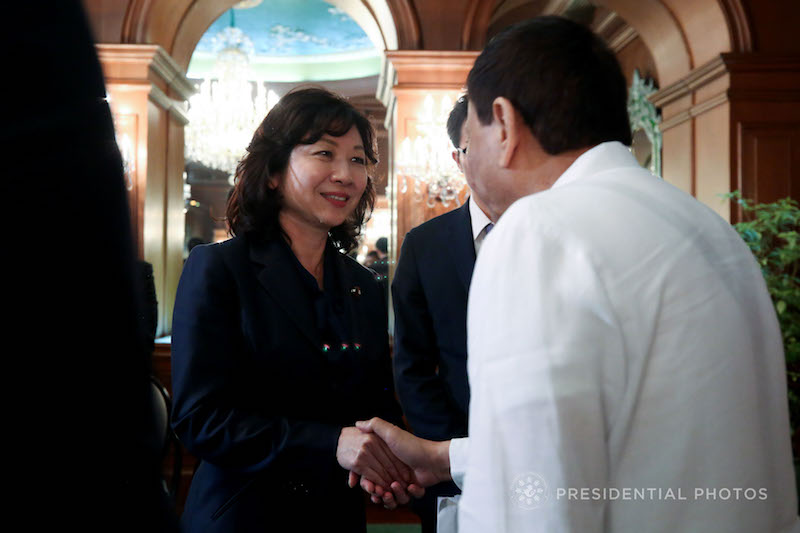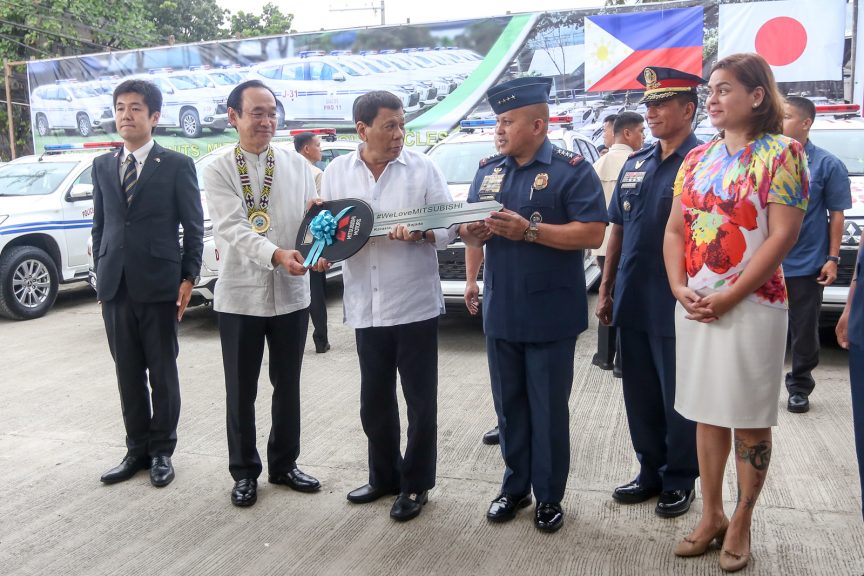DAVAO CITY (MindaNews / 16 January) — President Rodrigo Duterte acknowledges Japan as the largest contributor of aid to the Philippines and thanked it again during Monday’s turnover here of Japan’s donation of 26 units of Mitsubishi Montero to the Philippine National Police (PNP) for use as patrol cars.
But on the issue of the recently-installed ‘Comfort Women’ monument along Roxas Boulevard in Metro Manila, for which the Japanese government expressed regret, Duterte said he cannot stop the relatives or the surviving ‘comfort women’ from exercising their constitutional right to express their sentiments through the statue.
Duterte told MindaNews at the Presidential Guest House in Panacan on Friday that when the Japanese Minister of Internal Affairs and Communication Seiko Noda paid a courtesy call on him in Malacanang on January 9 he informed her that he “cannot stop the relatives or even the comfort women still living from their freedom to express what they are expressing through the statue.”
“That is a constitutional right which I cannot stop. It’s prohibitive for me to do that,” he said.
 President Rodrigo Roa Duterte gives a warm welcome to Japan Minister of Internal Affairs and Communication Seiko Noda who paid a courtesy call on the President at the Malacañan Palace on January 9, 2017. TOTO LOZANO/PRESIDENTIAL PHOTO
President Rodrigo Roa Duterte gives a warm welcome to Japan Minister of Internal Affairs and Communication Seiko Noda who paid a courtesy call on the President at the Malacañan Palace on January 9, 2017. TOTO LOZANO/PRESIDENTIAL PHOTO
“Comfort women” were forced to work as sex slaves of Japanese occupation troops during World War II. Lila Pilipina documented 174 “comfort women” who had gone public and demanded justice since the early 1990s.
Reuters reported that in a comment on her ministry’s website, Noda said, “I spoke frankly to the President and I believe he understood.”
Duterte said the Japanese government did not demand the removal of the statue but expressed regret.
He said removing the statue is up to Erap, referring to Manila Mayor and former Philippine President Joseph Estrada. “Bahala siya” (It’s up to him).
The two-meter tall bronze sculpture of a blindfolded woman wearing a Filipiniana dress was unveiled at the Roxas Boulevard baywalk on December 8. The US and Japanese embassies are located along the boulevard.
Duterte said the issue “has not been raised to national policy” and that government was “buta, bungol” (blind and deaf) about its installation.
He reiterated Japan has always been coming to the aid of the Philippines, citing it as “the largest contributor of aids.”
“Lahat makita mo. Puro JICA (Japanese International Cooperation Agency) such as airports.
The National Historical Commission of the Philippines’ (NHCP) inscription on the monument says it symbolizes Filipino women who suffered abuses during the Japanese occupation from 1942 to 1945.
“Ang bantayog na ito ay alaala sa mga Pilipinang naging biktima ng pang-aabuso sa Pilipinas noong panahon ng pananakop ng Hapon (1942-1945). Mahabang taon ang lumipas bago sila tumestigo at nagbigay pahayag hinggil sa kanilang karanasan” [This monument is a memorial to Filipino women who have been victims of abuse during the Japanese occupation (1942-1945). Several years passed before they testified about their experience], the marker reads.
But while Duterte late Friday afternoon in Davao City said he had explained his stand to the Japanese minister, Foreign Affairs Secretary Alan Peter Cayetano earlier that afternoon in Manila said it was forming an inter-agency group to look into the “Comfort Women” statue.
GMA7 News quoted Cayetano as saying he cannot disclose the Department of Foreign Affairs’ recommendation as the fact-finding process is ongoing, but hinted that the construction of the statue “will really affect certain feelings and relationships.”
“I don’t think it will be good,” Cayetano said, but noted that the DFA’s position is “always based on Filipino interest.”
“There’s no final findings yet from the inter-agency group and I think they are still in the stage of fact-finding – who put it up, why did they put it up, where do they put it up, who got the permits,” Cayetano said.
He acknowledged that they were “surprised” when the monument was put up. He said his office was not consulted.
 Japanese Ambassador to the Philippines Koji Haneda (2nd from L) turns over 26 Mitsubishi Montero units as police patrol cars to Philippine President Rodrigo Duterte (3rd from L) and Philippine National Police (PNP) Chief Ronald Dela Rosa as Davao City Mayor Sara Duterte (R) and Davao Region Police Chief Manuel Gaerlan (2nd from Right) look on in a ceremony during the inauguration of the PNP’s Regional Crime Laboratory in Davao City on 15 January 2018. MindaNews photo by MANMAN DEJETO
Japanese Ambassador to the Philippines Koji Haneda (2nd from L) turns over 26 Mitsubishi Montero units as police patrol cars to Philippine President Rodrigo Duterte (3rd from L) and Philippine National Police (PNP) Chief Ronald Dela Rosa as Davao City Mayor Sara Duterte (R) and Davao Region Police Chief Manuel Gaerlan (2nd from Right) look on in a ceremony during the inauguration of the PNP’s Regional Crime Laboratory in Davao City on 15 January 2018. MindaNews photo by MANMAN DEJETO
The Philippine Daily Inquirer on December 20 last year quoted Manila City Administrator Jojo Alcovendaz as saying that it was the NHCP that allowed a foundation to erect the statue.
Alcovendaz said the DFA wrote the city on December 12 to explain what led to the installation of the statue. He also told the Inquirer that the deputy chief of mission of the Japanese Embassy also went to City Hall to inquire about it.
Alcovendaz said the statue was commissioned by Tulay Foundation, a Manila-based group composed of members of the Chinese-Filipino community, and was unveiled on Dec. 8 by officials led by NHCP executive director Ludovico Badoy. Alcovendaz represented Estrada during the event.
Duterte and Japanese Prime Minister Shinzo Abe are close friends. Last year, Abe and his wife even had breakfast in Duterte’s residence.
Japanese Ambassador to the Philippines Koji Haneda turned over the 26 Mitsubishi Montero units to the PNP in rites attended by Duterte, PNP Director General Ronald Dela Rosa, Davao City Mayor Sara Duterte and other officials during the inauguration of the PNP’s Regional Crime Laboratory last Monday. (Carolyn O. Arguillas / MindaNews)
